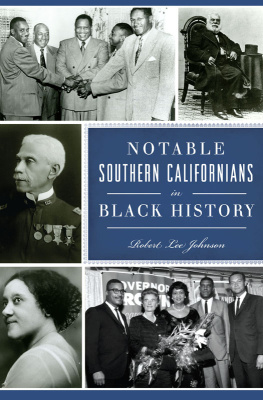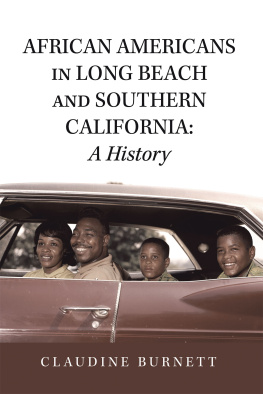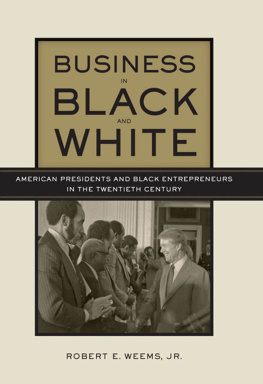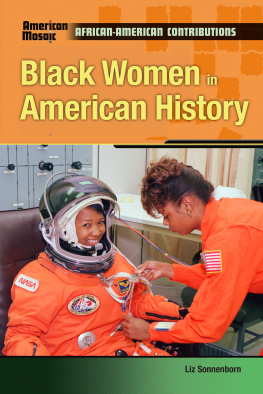

Published by The History Press
Charleston, SC
www.historypress.net
Copyright 2017 by Robert Lee Johnson
All rights reserved
First published 2017
e-book edition 2017
ISBN 978.1.62585.115.4
Library of Congress Control Number: 2016950696
print edition ISBN 978.1.62619.581.3
Notice: The information in this book is true and complete to the best of our knowledge. It is offered without guarantee on the part of the author or The History Press. The author and The History Press disclaim all liability in connection with the use of this book.
All rights reserved. No part of this book may be reproduced or transmitted in any form whatsoever without prior written permission from the publisher except in the case of brief quotations embodied in critical articles and reviews.
CONTENTS
ACKNOWLEDGEMENTS
I can think of many people who have been generous with their time, assistance and encouragement, but the one on whom I relied the most is my wife, Karani Marcia Johnson. She lost me for almost two yearsI was here but I was not here, as I was usually lost in research on this book and was not able to provide her with my presence or my companionship. But she was still encouraging and helpful and, most importantly, understanding. I thank her with all of my heart. I also would like to thank Mr. Charles Matthews, the nephew of Miriam Matthews and the trustee of her collection. He is a kind and generous man who is deserving of the great responsibility that his aunt has placed on him. I would like to thank George Davis, executive director of the California African American Museum (CAAM), for his help. I would like to thank Ben Gibson of The History Press for his patience and guidance; my son, Devin Cole Johnson; my twin granddaughters, Aaliyah Gaynelle Johnson and Alisa Loretta Johnson, who I am going to visit as soon as Im finished with this book; my stepson, Nissan Thomas; his partner, Ayana Chapman; and my newest granddaughter, Eden Brook Thomas. May you all go boldly into the future enriched by the knowledge of our past.
INTRODUCTION
The history of California does not fit neatly into the American narrative. It is a conquered land, having been won in the Mexican-American War of the 1840s that ceded most of the Southwest to the United States in a fulfillment of the imperialistic dream of Manifest Destiny, which was the true motivation for the war. On January 13, 1847, Lieutenant Colonel John C. Frmont and Mexican general Andrs Pico, the brother of Mexican California governor Pio Pico, signed the Treaty of Cahuenga, which ended the fighting in Alta California. During the war, most of the resistance to the American invasion of Mexican California took place in Southern California. The Battle of San Pasqual made Andrs Pico a military hero and eventually led to his promotion as head of the remaining Mexican forces. Under the Treaty of Cahuenga, the residents of the conquered Mexican state of Alta California could keep their lands and retain their language.
Unfortunately, even before California became a state in 1850, powerful American interests and their politicians sought to undermine the treaty. One of Californias first senators, William Gwin (the other senator being former lieutenant colonel John C. Frmont), established the land commission that put the burden of proof of ownership on the families of the grantees of Spanish and Mexican land grants. This former Mississippi senator, who was now the senator from the new state of California, also authored bills that denied nonwhites the ability to seek redress against white men in court, making it that much easier for the new American politicians and businessmen to line their pockets at the expense of the old order. From 1850 to 1880, there was a huge transfer of wealth from the old order of Californio landowners to the new American settlers. By 1890, the California that existed before 1850 was becoming a quaint, romantic myth, populated by descendants of pureblood Castilian Spaniards who were not tainted by Moorish blood and accepted American rule with open arms.
Contrary to the myth, the fact was that men and women of African descent had settled into California as early as 1769. At the end of the Mexican-American War, some of the largest landowners in the state were of African descent. The mythical Zorro was most likely based on Don Solomon Pico (a man of African descent and cousin of Don Pio Pico), who became an outlaw and resisted the American occupation after the war. The Solomon Hills, adjacent to the city of Santa Barbara, are named for him.
By the 1890s, most of these Californio landowners had lost their land to American squatters, predatory lenders, taxes and theft. At the same time, formerly enslaved Africans in the United States sought new opportunities in California. Bridget Biddy Mason, a formerly enslaved real estate investor and philanthropist, was known to converse with Don Pio Pico over lunch at his Pico House Hotel on Main Street. (The hotel is still standing at the south end of Olvera Street.) Im sure they mustve had some very enlightening conversations. Don Pio Pico spoke no English, but Bridget Biddy Mason spoke Spanish and was able to incorporate his advice into her daily business dealings. Her grandson Robert C. Owens would become one of the wealthiest men in Los Angeles in the early twentieth century and a philanthropist in his own right with his financial support of Colonel Allen Allensworths vision of a Tuskegee of the West, which became the Black township of Allensworth.
The Black communitys struggle for equality in California can be traced back to the Colored Conventions Movement of the 1850s, the National Association for the Advancement of Colored People (NAACP), Marcus Garveys Universal Negro Improvement Association (UNIA) and the Womens Political Study Clubs of the early twentieth century right up to the establishment of the Black Panther Party in 1966. The city of Compton, California, elected the first Black mayor of a major municipality west of the Mississippi in 1969 and had a majority Black school board and city council. By 1973, Mayor Tom Bradley had become the first Black mayor in the modern era of Los Angeles, California, the second-largest city in the United States.
The aim of this book is to highlight a few of the stories of some of the amazing people who contributed greatly to Southern California but are not often heard about. I hope by reading these profiles that the reader will become curious and want to know more about these and the many other unsung heroes and become inspired to carry their torch into the future.
R.L.J.
Chapter 1
BLACK PIONEERS IN SPANISH CALIFORNIA
In the year 1510, Spanish author Garcia de Montalvo wrote Las Sergas de Esplandian (The Deeds of Esplandian), an epic novel about Spanish chivalry. One of the fictional characters in the popular story was Queen Calafia, the courageous leader of a race of Black Amazons. In the book, she is described as the most beautiful of a long line of Queens who ruled over California, a mythical island. Calafia and her women warriors were said to wear gold armor adorned with many precious stones.
from the book Women Trailblazers of California
LUIS MANUEL QUINTERO
In late June 1542, Juan Rodriguez Cabrillo, who had been ordered by the viceroy of New Spain, Antonio de Mendoza, to explore and map the northern Pacific coast, was sailing north, leaving behind the shipyards at Barra de Navidad, New Spain, to begin his journey of exploration along the coast of Alta California. Two years earlier, Cabrillo and his fleet of three shipsthe
Next page









